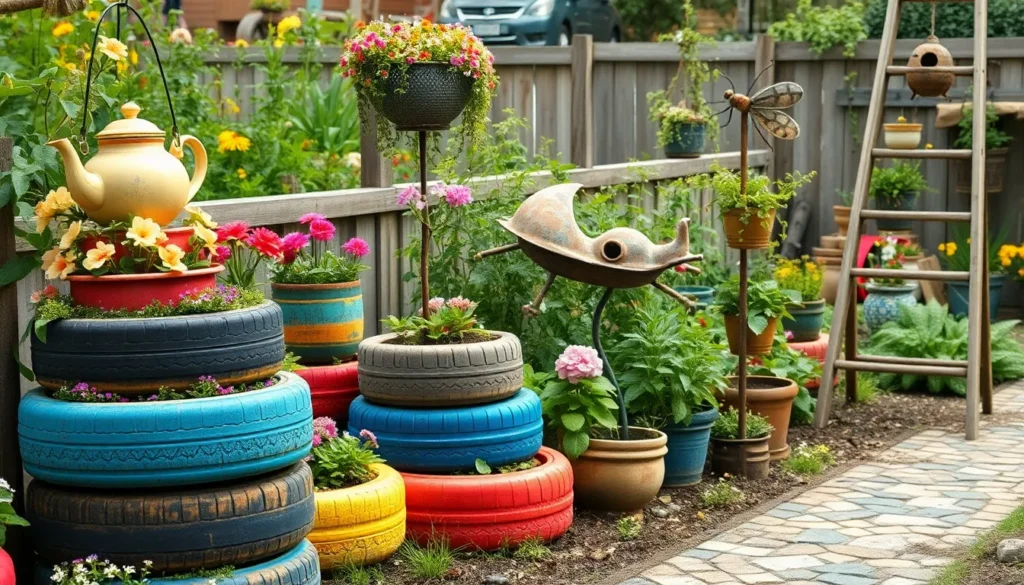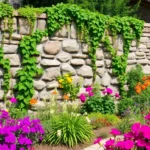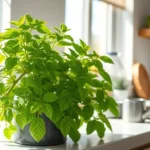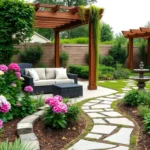We’ve all got those forgotten items cluttering our garages and storage spaces – old tires, broken chairs, rusty metal scraps, and worn-out containers that seem destined for the landfill. But what if we told you these “useless” items could transform your garden into a stunning outdoor masterpiece?
Garden art from junk isn’t just about recycling – it’s about unleashing your creativity while saving money and helping the environment. We’re talking about turning discarded materials into eye-catching planters, whimsical sculptures, and functional garden features that’ll make your neighbors stop and stare.
The best part? You don’t need artistic training or expensive tools to create beautiful garden art. With some imagination and basic supplies, we can show you how to breathe new life into forgotten treasures and create unique pieces that reflect your personality while adding character to your outdoor space.
Transform Old Tires Into Colorful Garden Planters
Old tires present one of the most versatile opportunities for creating stunning garden art from everyday junk. We can breathe new life into these rubber relics with simple techniques that turn them into functional and beautiful garden features.
Paint and Stack Tires for Tiered Gardens
Paint transforms discarded tires into vibrant planters that rival expensive garden containers. We recommend using exterior acrylic paint or specialized rubber paint that withstands weather conditions and UV rays. Bright colors like turquoise, coral, sunshine yellow, and lime green create eye-catching focal points in any garden space.
Stack painted tires to create multi-level planting systems that maximize growing space in small gardens. We typically stack 2-3 tires for optimal stability and visual appeal. The bottom tire should be the largest, with progressively smaller tires stacked on top when available. Fill each tire with quality potting soil and plant herbs, flowers, or vegetables based on your garden’s needs.
Arrange stacked tire planters along fence lines or in corner spaces where traditional planters might not fit. We’ve found that painting each tire in the stack a different shade of the same color family creates beautiful ombre effects that photograph beautifully for social media sharing.
Create Tire Swings for Garden Entertainment
Tire swings add whimsical charm while providing entertainment value in family gardens. We suggest selecting tires with deeper treads for better grip and visual interest. Clean the tire thoroughly with degreasing soap before painting or installing to ensure paint adhesion and remove any oils.
Hang tire swings from sturdy tree branches using marine-grade rope or heavy-duty chains rated for outdoor use. We recommend positioning swings at least 8 feet from tree trunks and other obstacles to ensure safe swinging space. The hanging height should allow users’ feet to touch the ground when seated.
Paint tire swings in bright colors or fun patterns to make them standout garden features. We often see zebra stripes, polka dots, or rainbow designs that appeal to children and adults alike. Consider adding weather-resistant cushions or rope padding for extra comfort during use.
Turn Tires Into Decorative Garden Borders
Transform old tires into permanent garden borders that define planting areas and pathways. We cut tires in half lengthwise using reciprocating saws with fine-tooth blades designed for rubber cutting. This creates two curved border sections from each tire.
Paint the tire borders in colors that complement your garden’s color scheme before installation. Earth tones like deep brown, forest green, or terracotta blend naturally with garden landscapes, while bright colors create modern, artistic statements.
Install tire borders by partially burying them cut-side down in shallow trenches around flower beds or vegetable gardens. We typically bury about one-third of the tire border underground for stability. The curved sections fit together seamlessly to create flowing, organic-looking borders that cost significantly less than traditional edging materials.
Repurpose Kitchen Items as Garden Art Sculptures
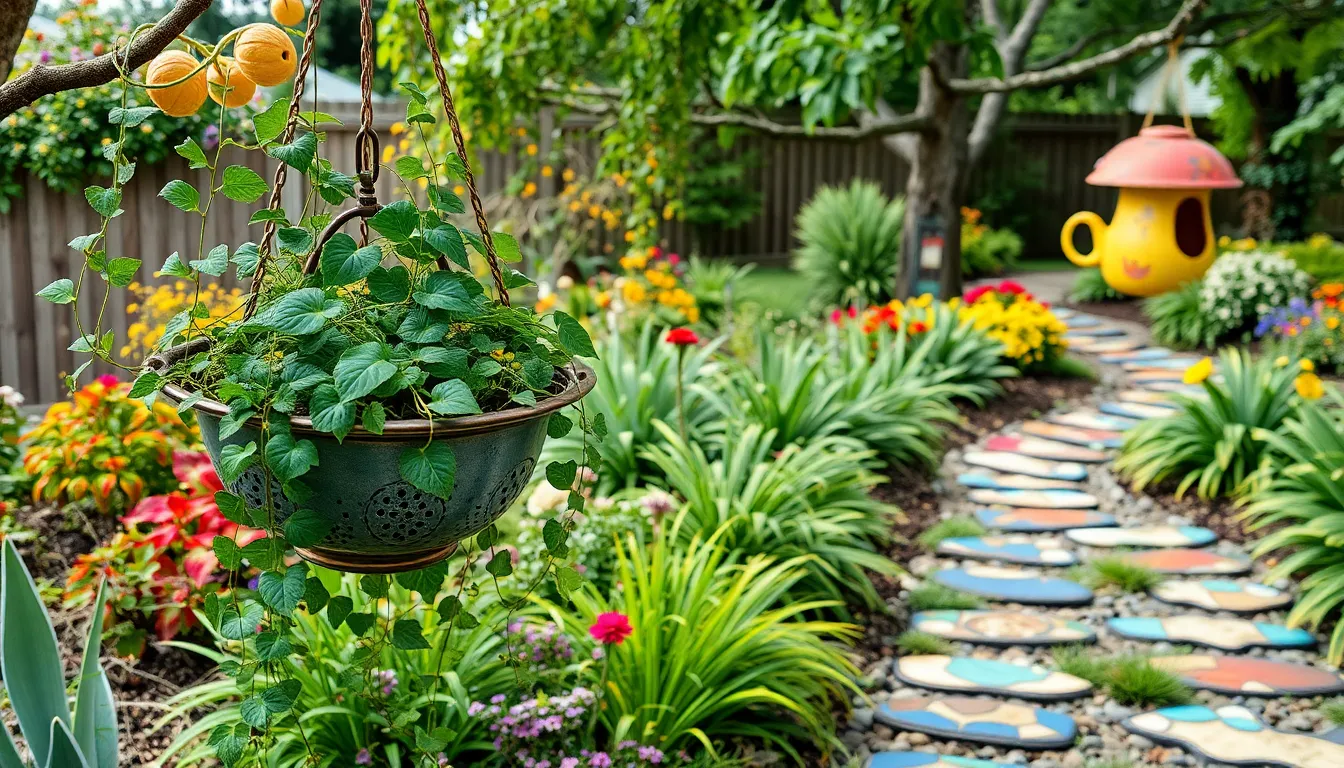
Kitchen items that have outlived their culinary purpose can find new life as stunning garden art sculptures. We’ll transform everyday utensils and dishware into functional decorative pieces that add personality to our outdoor spaces.
Convert Old Colanders Into Hanging Planters
Colanders make excellent hanging planters with their built-in drainage system. We can line old colanders with coco fiber or place small pots inside to create charming suspended gardens.
Thread sturdy chains through the handles and hang them from pergolas, tree branches, or garden hooks. The perforated design allows excess water to drain naturally while creating interesting shadow patterns below.
Plant trailing varieties like ivy, petunias, or string of pearls to cascade beautifully through the holes. We’ve found that colanders work particularly well for herb gardens, allowing us to position fresh herbs at eye level for easy harvesting.
Transform Vintage Teapots Into Whimsical Bird Houses
Vintage teapots create delightful bird houses that attract feathered visitors to our gardens. We attach small wooden or metal perches beneath the spout opening to give birds a comfortable landing spot.
Adding a protective roof above the teapot shields birds from harsh weather conditions. Fill the interior with birdseed initially to encourage birds to discover their new home.
Position teapot bird houses at varying heights throughout the garden to accommodate different bird species. The spout serves as the perfect entrance hole, while the handle provides a convenient mounting point for hanging or securing to posts.
Use Mismatched Dishes for Mosaic Stepping Stones
Mismatched dishes transform into beautiful mosaic stepping stones that add artistic flair to garden pathways. We break dishes into various sized pieces and arrange them in decorative patterns on concrete stepping stone forms.
Creating geometric designs with contrasting colors produces striking visual effects along garden paths. Mix plates, bowls, and saucers to achieve different textures and patterns in each stepping stone.
Apply tile adhesive to secure the ceramic pieces, then fill gaps with weather-resistant grout. These custom stepping stones cost significantly less than purchased alternatives while incorporating personal memories from cherished dishware pieces.
Create Stunning Wind Chimes From Household Debris
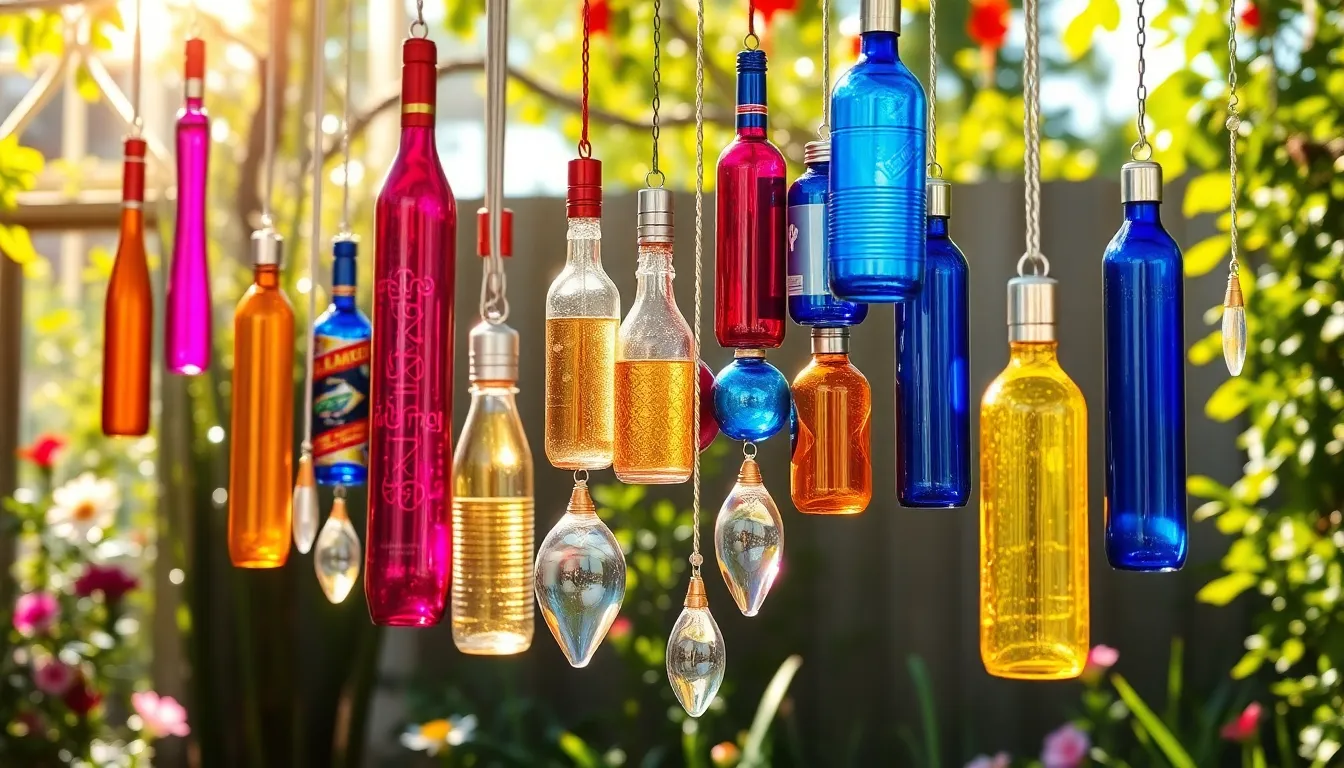
We can transform ordinary household items into beautiful melodic garden features that add both visual appeal and soothing sounds to our outdoor spaces. These creative wind chime projects turn forgotten debris into enchanting musical installations that catch every breeze.
Fashion Musical Elements From Old Silverware
Old silverware offers endless possibilities for crafting unique wind chimes that produce delightful tinkling sounds. We can gather mismatched forks, knives, and spoons from our kitchen drawers and attach them to a sturdy metal rod or wooden branch using fishing line or thin wire. Different lengths create varying tones when the pieces strike each other in the wind.
Stainless steel utensils work particularly well because they resist rust and produce clear, bell-like sounds. We should drill small holes near the handle ends to ensure secure attachment points. Spacing the pieces about 2-3 inches apart prevents tangling while allowing enough movement for optimal sound production.
Design Melodic Displays Using Glass Bottles
Glass bottles create gentle clinking sounds that add a peaceful ambiance to our garden spaces. We can collect various sized bottles and hang them at different heights to produce a range of tones when they bump together. Clear bottles work beautifully, but colored glass adds visual interest while maintaining the melodic qualities.
For enhanced sound effects, we can partially fill bottles with different amounts of water to create distinct pitches. Each bottle becomes a unique musical note when struck by the wind or neighboring bottles. Mason jars, wine bottles, and even small perfume bottles all contribute different tonal qualities to our homemade wind chime symphony.
Create Gentle Sounds With Aluminum Cans and Lids
Aluminum cans and their lids transform into lightweight percussion instruments that respond beautifully to even gentle breezes. We can clean and dry various sized cans, then punch holes near the top edge for hanging. Different can sizes produce different tones, from deep soup cans to higher-pitched soda cans.
Flattened aluminum lids create excellent striking surfaces that produce soft metallic sounds. We attach these lids to the bottom of our can wind chimes using short lengths of string or wire. The lightweight nature of aluminum means our wind chimes will dance and sing even in light air movement, creating continuous gentle sounds throughout the day.
Build Unique Garden Structures From Discarded Materials
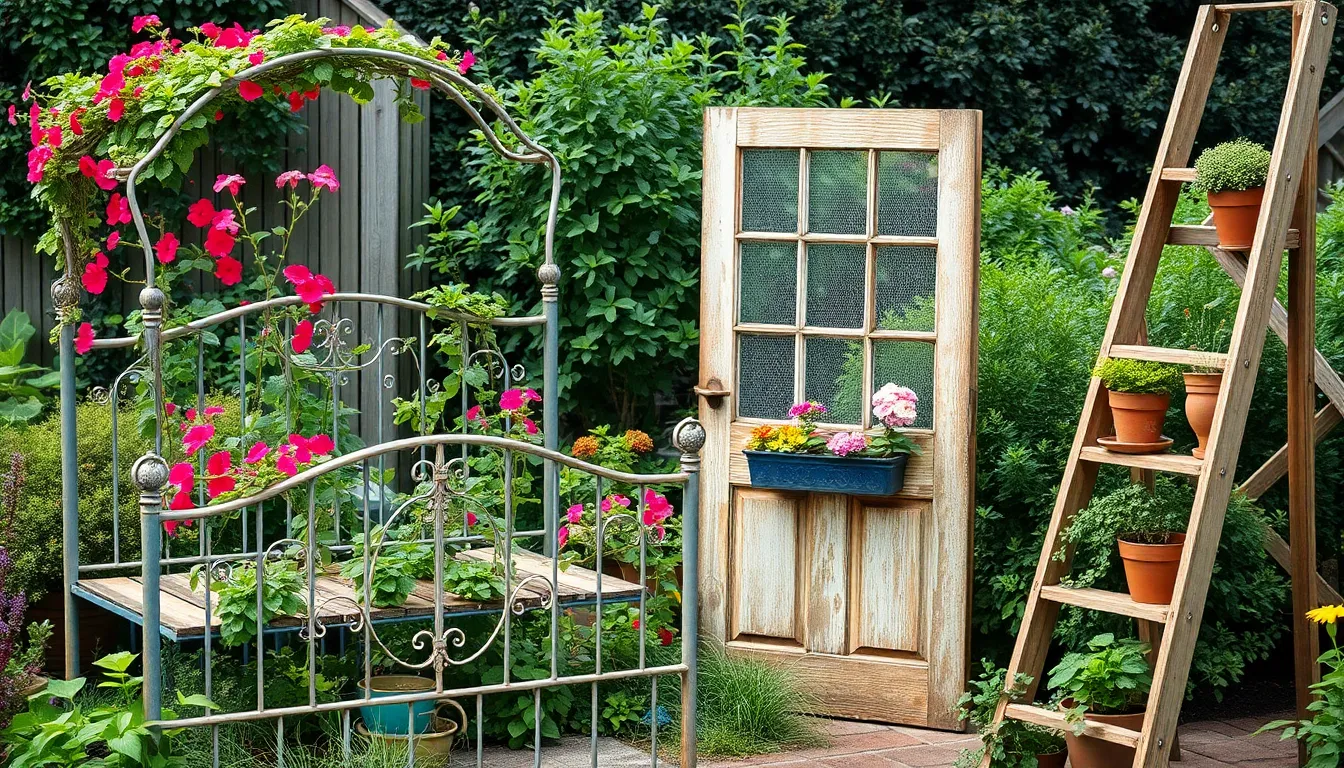
We’ll transform larger discarded items into functional garden structures that serve both practical and aesthetic purposes. These forgotten furniture pieces and architectural elements can become the backbone of your garden design.
Construct Trellises Using Old Bed Frames
Construct stunning vertical growing structures by repurposing vintage bed frames into custom garden trellises. Metal bed frames work exceptionally well for this project because they’re already designed to support weight and withstand regular use. Position the headboard and footboard parallel to each other to create an instant framework for climbing plants like morning glories, clematis, or pole beans.
Transform the existing bed slats into horizontal support bars by securing them between the frame sections. We recommend spacing these slats 12 to 18 inches apart to provide adequate climbing support for different plant varieties. Secure each slat with heavy duty zip ties or metal brackets to ensure they can handle the weight of mature vines.
Create multiple growing levels by adding wire mesh or twine between the frame sections. This additional support system allows smaller climbing plants to establish themselves before reaching the main framework. Paint the entire structure with rust resistant outdoor paint to extend its lifespan and coordinate with your garden’s color scheme.
Design Garden Gates From Vintage Screen Doors
Design charming entrance points by converting old screen doors into decorative garden gates that add instant character. Screen doors are particularly suitable for this project because they’re lightweight yet sturdy enough to function as actual barriers. Remove any damaged screening and replace it with decorative elements like chicken wire, bamboo panels, or even climbing plant supports.
Install proper hinges and latches to ensure your repurposed gate functions smoothly for years to come. We suggest using galvanized hardware to prevent rust and ensure longevity in outdoor conditions. Mount the door between two sturdy posts or integrate it into existing fence structures for a cohesive look.
Enhance the door’s garden appeal by adding window boxes or small planters directly to the frame. Attach shallow containers to the bottom rail or create hanging displays from the top section. These additions transform a simple barrier into a living art piece that welcomes visitors while providing additional growing space for herbs or flowers.
Assemble Plant Stands Using Wooden Ladders
Assemble multi level display areas by converting old wooden ladders into rustic plant stands that maximize your growing space. Step ladders work particularly well because they’re self supporting and provide multiple shelf levels without requiring additional mounting hardware. Position potted plants, herbs, or succulents on each step to create an eye catching vertical garden display.
Secure additional shelving between ladder rungs to increase your planting capacity and create custom sized growing areas. Cut reclaimed wood boards to fit between the ladder sides and attach them with wood screws or metal brackets. These added shelves accommodate different pot sizes and create opportunities for trailing plants to cascade naturally.
Weather treat your ladder plant stand to ensure it withstands outdoor conditions throughout multiple growing seasons. Apply outdoor wood stain or paint to protect against moisture damage and UV fading. Consider adding casters to the bottom for easy repositioning as your garden layout changes or seasonal growing needs shift.
Fashion Garden Creatures From Scrap Metal and Tools
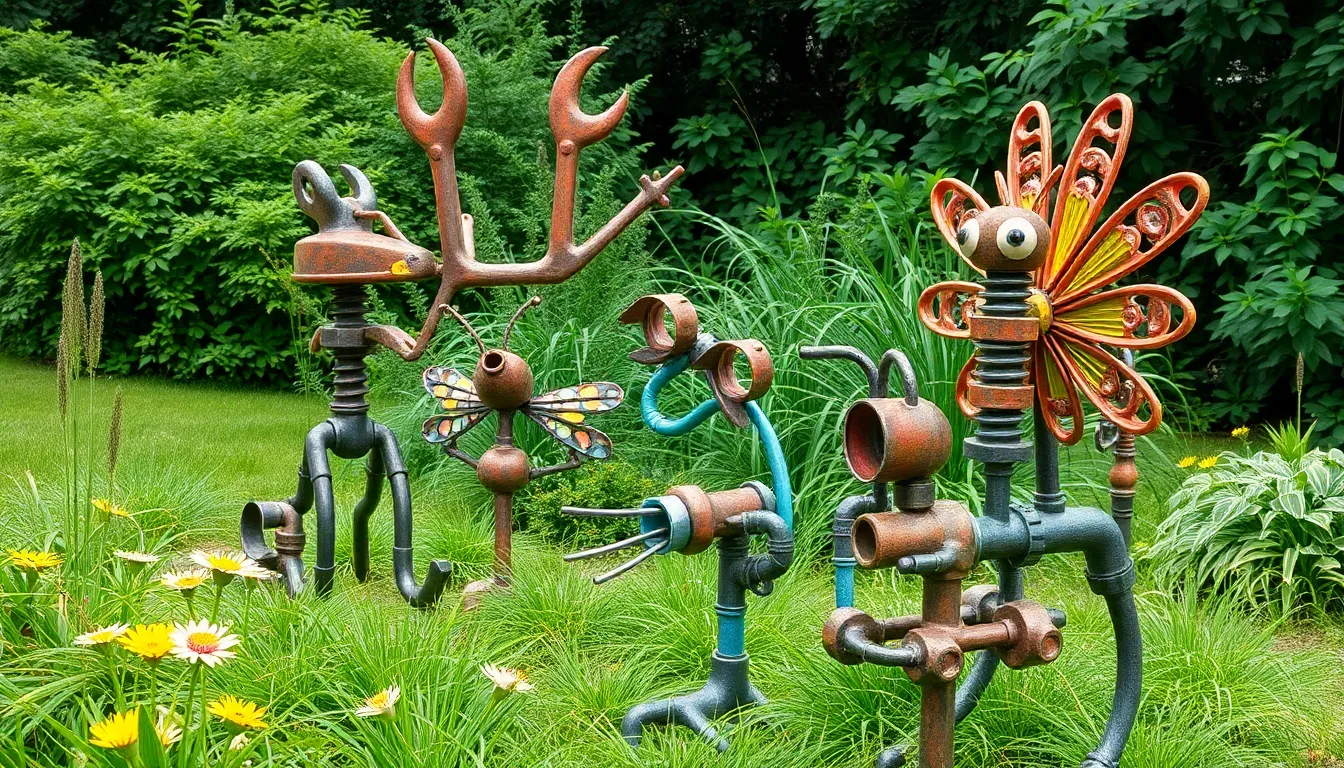
Old metal scraps and discarded tools offer endless possibilities for creating whimsical garden inhabitants. We can transform these forgotten materials into captivating creatures that bring personality and charm to our outdoor spaces.
Sculpt Animals Using Old Garden Tools
Garden tools naturally lend themselves to animal sculptures with their distinctive shapes and rustic appeal. We recommend starting with rakes, shovels, hoes, and spades as the foundation for various creatures. The curved handle of an old shovel becomes the perfect neck for a swan or giraffe, while rake tines transform into flowing feathers or hair.
Welding these tools together creates sturdy connections that withstand outdoor weather conditions. We’ve found that the rusted patina and weathered surfaces add authentic character to our metal menagerie. Consider fashioning birds by positioning multiple rake heads as wings and tail feathers, or create frogs using rounded shovel blades for bodies and smaller hand tools for limbs.
The varied textures and shapes of different tools contribute to realistic animal features. Spade heads work exceptionally well as animal faces or body sections, while long handles provide structural support and elegant proportions for larger creatures.
Create Insects From Nuts, Bolts, and Hardware
Small hardware components excel at capturing the intricate details of garden insects. We use nuts and bolts to form segmented insect bodies, creating realistic proportions that mimic dragonflies, bees, and butterflies. Different sized washers stack perfectly to represent compound eyes or wing segments.
Spring coils and bent wire become flexible antennae and delicate legs that move naturally in garden breezes. We often combine various bolt sizes to achieve the tapered body segments characteristic of many insects. Adding colorful automotive paint or metal patinas brings these creatures to life with vibrant hues that complement surrounding flowers.
Screws of different lengths work beautifully as wing supports when attached to thin metal sheets or repurposed ceiling fan blades. We position these hardware insects throughout garden beds where they appear to have naturally landed among the plants.
Design Abstract Figures With Pipe Fittings
Plumbing components offer geometric possibilities for modern garden sculptures that serve as striking focal points. We connect pipe fittings, valves, and coupling joints in creative configurations to build abstract figures that challenge traditional garden art concepts. These industrial materials create contemporary sculptures that contrast beautifully with organic garden elements.
T joints and elbow fittings become building blocks for humanoid figures or geometric animals. We layer different pipe diameters to achieve visual depth and dimensional interest in our abstract creations. Pressure valves and gauge components add mechanical details that celebrate the beauty of industrial design.
These abstract sculptures work particularly well in modern industry designs where clean lines and geometric forms complement architectural elements. We position them strategically as conversation pieces that showcase our creativity while promoting sustainable recycling practices.
Design Functional Art Using Broken Pottery and Ceramics
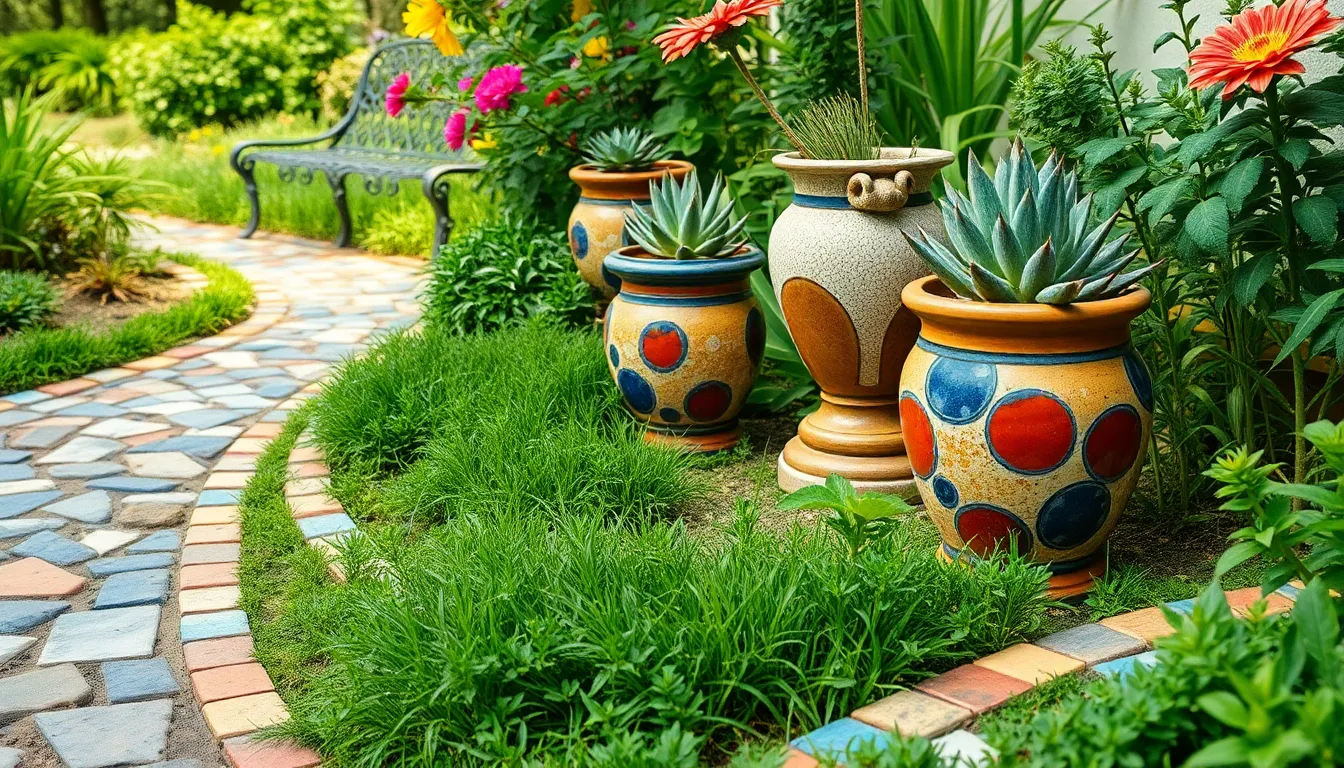
Broken pottery and ceramics offer incredible potential for creating stunning functional garden art that transforms waste into beautiful decorative elements. We can repurpose these shattered treasures into vibrant, practical pieces that enhance our outdoor spaces while promoting sustainable gardening practices.
Create Mosaic Pathways From Shattered Dishes
Shattered dishes become the perfect foundation for creating whimsical mosaic garden pathways that add artistic flair to our outdoor spaces. We arrange colorful pottery shards and ceramic fragments in unique patterns directly onto concrete surfaces or packed soil, creating durable walkways that withstand weather while showcasing our personal design aesthetic.
Design possibilities expand when we mix different colored ceramics like blue dinner plates, yellow serving bowls, and green teacups to create stunning geometric patterns or flowing organic designs. Breaking dishes safely requires placing them in cloth bags before tapping with a hammer, ensuring we get manageable pieces that fit together seamlessly.
Installation becomes simple when we press fragments into wet concrete or adhesive, leaving small gaps between pieces that we later fill with grout or sand. Our finished pathways not only guide visitors through the garden but also catch sunlight beautifully, creating dazzling reflections that change throughout the day.
Build Colorful Garden Borders With Tile Fragments
Tile fragments from broken ceramics transform ordinary garden bed edges into eye catching artistic borders that define our planting spaces with style and creativity. We embed these colorful pieces along walkways and around flower beds, using ceramic shards from old bathroom tiles, kitchen backsplashes, and decorative pottery to create stunning visual boundaries.
Creating these borders requires minimal tools and supplies, making this project accessible for gardeners of all skill levels. We simply dig shallow trenches along our desired border lines, then arrange tile fragments in appealing patterns before securing them with garden adhesive or concrete.
Color coordination becomes our artistic playground as we combine complementary ceramic pieces like terra cotta pot fragments with blue tile pieces, or mix neutral grays with bright accent colors from decorative dishes. These borders help prevent soil erosion while adding permanent decorative elements that require virtually no maintenance once installed.
Create Decorative Planters Using Cracked Vessels
Cracked vessels like damaged pots, bowls, and ceramic containers become unique decorative planters that embrace imperfection while extending the life of damaged ceramics. We transform these flawed pieces into charming containers for succulents, herbs, and small flowering plants, turning what might be trash into treasured garden focal points.
Drainage improves naturally in cracked vessels, making them ideal for plants that prefer well draining soil conditions like lavender, rosemary, and various succulent varieties. We can enhance existing cracks by carefully widening them with small tools, creating interesting planting pockets that add visual texture and allow for creative plant arrangements.
Decorative appeal increases when we group multiple cracked planters of varying sizes and colors throughout our garden spaces, creating cohesive displays that tell a story of renewal and creativity. These repurposed vessels work especially well for herb gardens near kitchen windows, where their unique character adds charm while providing fresh ingredients for cooking.
Transform Fabric Scraps Into Weather-Resistant Garden Decor
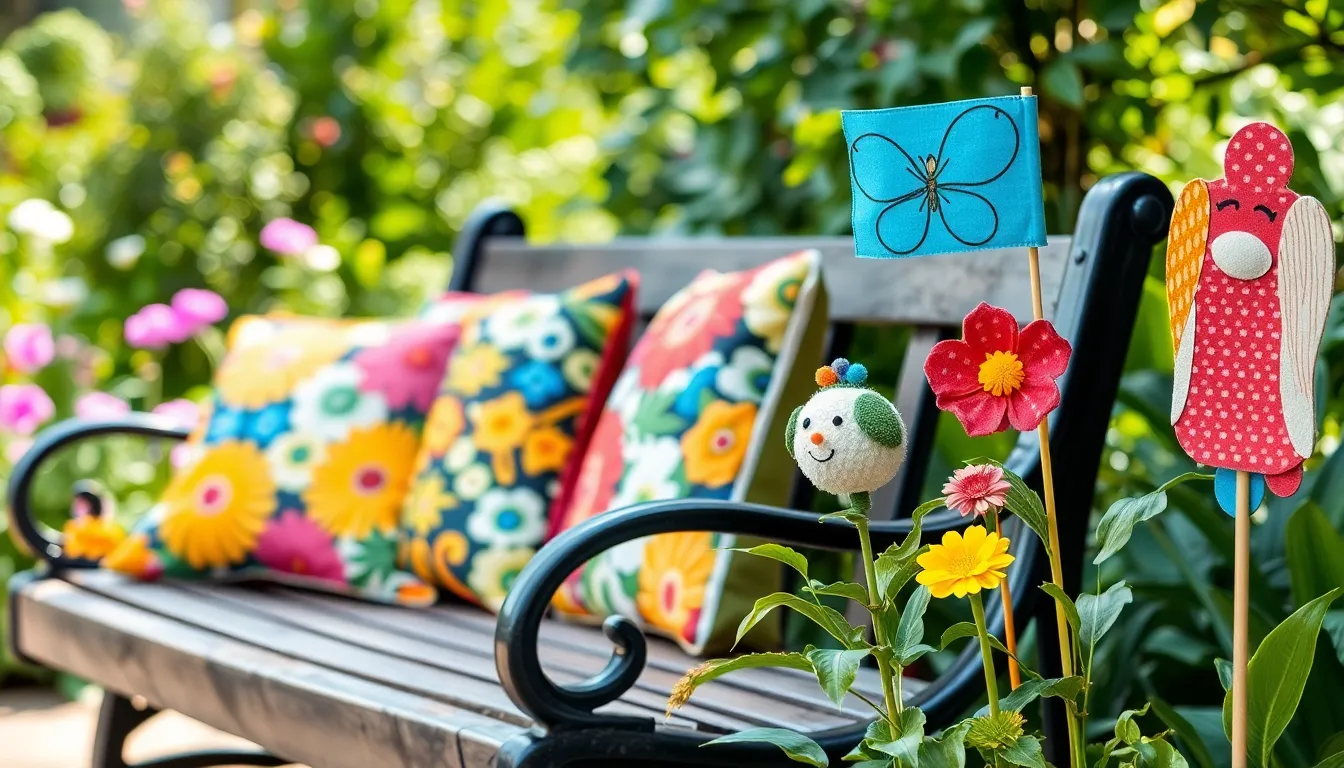
Fabric scraps don’t have to end up in landfills when they can become beautiful garden decorations. We’ll show you how to weatherproof textiles and turn them into durable outdoor art that withstands rain and sun exposure.
Sew Outdoor Cushions From Old Upholstery
Transform discarded upholstery fabric into comfortable garden seating by creating custom outdoor cushions. We recommend using heavy-duty fabrics from old furniture such as sofas, chairs, or automotive seats since they’re already designed for durability. Apply weatherproof spray or marine-grade fabric sealant to make them water-resistant before sewing.
Measure your garden furniture seats and cut fabric pieces with 2-inch seam allowances on all sides. Sew the pieces together using strong outdoor thread and add foam padding or stuffing from old pillows. Insert waterproof zippers to create removable covers that you can wash when needed.
Position these repurposed cushions on garden benches, patio chairs, or even tree stumps to create comfortable outdoor seating areas. The unique patterns and textures from vintage upholstery add character that you can’t buy in stores.
Create Garden Flags From Vintage Textiles
Design charming garden flags using old clothes, curtains, or bedsheets that tell your personal story. We suggest selecting fabrics with interesting patterns or sentimental value such as vintage band shirts, grandmother’s aprons, or children’s outgrown clothing.
Cut fabric pieces into flag shapes measuring 12 by 18 inches for optimal visibility in garden settings. Treat each piece with waterproof fabric spray before sewing reinforced hems along the edges. Add grommets or create fabric loops for hanging on garden stakes or poles.
Display these textile flags throughout your garden beds to mark seasonal plantings or create themed areas. The nostalgic elements bring personal history into your outdoor space while adding movement and color that changes with the breeze.
Design Plant Markers Using Fabric and Wire
Create whimsical plant markers by wrapping colorful fabric scraps around shaped wire forms. We recommend using 12-gauge galvanized wire for durability and bending it into simple shapes like hearts, stars, or plant silhouettes. Secure fabric strips with outdoor adhesive or by wrapping tightly and tucking ends.
Attach weatherproof plant labels to the wire stems using small zip ties or waterproof glue. Write plant names on plastic tags or laminated paper before securing them to the fabric-wrapped markers. This combination creates functional art that’s both informative and decorative.
Install these fabric plant markers throughout your vegetable garden or flower beds to identify different varieties while adding pops of color. The soft textile elements create visual interest against the natural backdrop of soil and foliage.
Conclusion
We’ve shown you that creating stunning garden art doesn’t require expensive materials or professional skills. Every forgotten item in your storage space holds potential to become something beautiful and functional for your outdoor sanctuary.
The possibilities are truly endless when we embrace this creative mindset. From tire planters to metal sculptures and mosaic pathways we can transform any discarded item into garden magic that reflects our unique style.
Start small with one project that excites you most. Once you experience the satisfaction of breathing new life into forgotten treasures you’ll find yourself looking at everyday items with fresh eyes and endless creative possibilities.
Frequently Asked Questions
What items can I transform into garden art?
Almost any forgotten item can become garden art! Old tires, broken furniture, kitchen utensils, silverware, glass bottles, aluminum cans, bed frames, screen doors, wooden ladders, scrap metal, garden tools, broken pottery, ceramics, and fabric scraps all have potential. The key is looking at discarded items with creativity and imagination to see their artistic possibilities.
Do I need artistic training to create garden art from recycled items?
No artistic training is required! The article emphasizes that anyone can create unique garden features with basic imagination and simple supplies. These projects focus on creativity and resourcefulness rather than technical skill, making them accessible to gardeners of all experience levels.
How can old tires be repurposed for garden art?
Old tires are incredibly versatile for garden projects. You can paint and stack them to create colorful tiered gardens, transform them into family-friendly swings, or use them as decorative borders for garden pathways. Basic painting techniques and creative stacking can turn tires into functional, attractive garden elements.
What kitchen items work well for garden art projects?
Kitchen items offer excellent repurposing opportunities. Old colanders make perfect hanging planters with built-in drainage, vintage teapots can become whimsical birdhouses, and mismatched dishes work wonderfully for creating personalized mosaic stepping stones. These projects combine functionality with decorative appeal while recycling household items.
How do I make wind chimes from household debris?
Create melodic wind chimes using various household items. Attach old silverware to a sturdy rod for tinkling sounds, use glass bottles at different heights for distinct pitches, or repurpose aluminum cans and lids for lightweight percussion. These projects add both visual appeal and soothing sounds to your garden.
Can large discarded items become functional garden structures?
Absolutely! Vintage bed frames make excellent garden trellises for climbing plants, old screen doors can be converted into charming garden gates, and wooden ladders transform into rustic multi-level plant stands. These larger projects combine practical functionality with aesthetic appeal while maximizing garden space.
How can I create garden creatures from scrap materials?
Transform scrap metal and discarded tools into whimsical garden creatures. Old garden tools can be reshaped into animal sculptures, nuts and bolts work perfectly for detailed insects, and plumbing fittings create striking abstract figures. These projects turn industrial materials into captivating focal points.
What can I do with broken pottery and ceramics?
Broken pottery offers numerous creative possibilities. Shattered dishes become colorful mosaic pathways, tile fragments create decorative garden borders that prevent soil erosion, and cracked vessels transform into unique planters with excellent drainage. These projects embrace imperfections while creating functional art.
How can fabric scraps be used for outdoor garden decor?
Transform fabric scraps into weather-resistant garden features by creating outdoor cushions from durable upholstery fabric, designing garden flags from vintage textiles, and making decorative plant markers using fabric and wire. Proper weatherproofing techniques ensure these fabric projects withstand outdoor conditions.
What are the benefits of creating garden art from recycled materials?
Creating garden art from recycled materials offers multiple benefits: it saves money on garden decorations, reduces waste and helps the environment, allows for creative self-expression, and creates unique pieces that reflect your personality. It’s an eco-friendly way to enhance your outdoor space while practicing sustainability.

